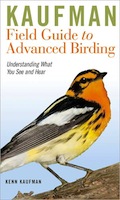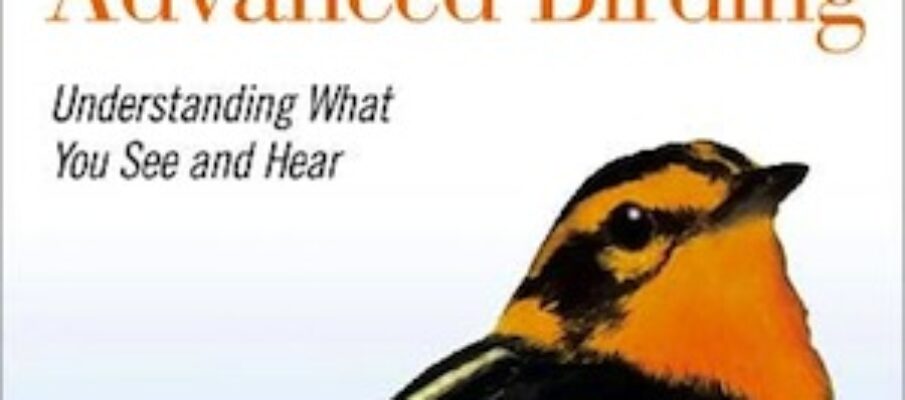“If you wish to know, seek first to understand.” When the statue of Kenn Kaufman is finally unveiled in the (alas, still yet to be built) Birding Hall of Fame, these words should be inscribed in bold letters across the front of the pedestal upon which it stands. It’s not a direct quote from Kaufman mind you; however it is the encapsulation of his philosophy of birding – a philosophy that has been decades in the making and which is now superbly explained in detail in his new Kaufman Field Guide to Advanced Birding; Understanding What You See and Hear.
 For those who might recall his 1999 book the Peterson Field Guide to Advanced Birding; Birding Challenges and How to Approach Them and wonder if this is simply a reprint of it or perhaps just an expanded edition, it is most certainly not the former nor is it very much the latter. It is, rather, the next step in Kaufman’s process of going ever deeper into the very heart of birding in order to bring to it as many people as whom may wish to learn how to do it not only better but also, in the mind of this reviewer, in a more mentally healthy way.
For those who might recall his 1999 book the Peterson Field Guide to Advanced Birding; Birding Challenges and How to Approach Them and wonder if this is simply a reprint of it or perhaps just an expanded edition, it is most certainly not the former nor is it very much the latter. It is, rather, the next step in Kaufman’s process of going ever deeper into the very heart of birding in order to bring to it as many people as whom may wish to learn how to do it not only better but also, in the mind of this reviewer, in a more mentally healthy way.
“Mentally healthy?” you may ask. Indeed. For in changing the emphasis between the 1999 book and this present one from “approaching challenges” to “understanding,” Kaufman has made perhaps one of the most positive steps in decades to lead birding away from its sometimes off-putting (especially for beginners) wonkish and nit-picky emphasis on memorizing vast catalogs of field marks and other minutiae and toward a more holistic method by which identification is learned through larger concepts and ideas in order that they may by dynamically applied as needed. Perhaps even more importantly, Kaufman has included the explicit statement that it is, even and perhaps especially for experienced birders, entirely acceptable to admit the times when one simply doesn’t know the identity of a particular bird.
Now this is, of course, not to say that Kaufman discounts the importance of developing a detailed knowledge of birds in order to facilitate the identification of them; far from it. The difference is in how and more particularly why this knowledge is acquired and accumulated. The key is observation. While the second half of the book is dedicated to addressing specific information regarding the differentiation of various bird families, Kaufman never relents in reminding his readers that it is through the time they spend actually looking at, watching the behavior of, and carefully examining the birds they see that they will come to know and thus be able to identify them more confidently in the future.
Lest it be thought by some that they are not yet ready for an “advanced” guide and thus may not be sufficiently able to comprehend all of what Kaufman explains in this book, it is here declared that no such thoughts should dissuade anyone from purchasing and reading this book at the earliest opportunity. Yes, some of the latter half may seem a bit over-whelming to those who are fairly new to birding; however the opening chapters are very much accessible to, and entirely appropriate for, birders at all levels of experience. Read as much of it as you deem appropriate to your current level of interest then come back to it later once what you read has sunk in and you have felt your field birding experiences enriched thereby.
As the old Buddhist proverb says, “when the student is ready, the teacher will appear.” With the publication of the Kaufman Field Guide to Advanced Birding, we can all be assured that our teacher is ready at hand whenever we are.
 Book Title: Kaufman Field Guide to Advanced Birding; Understanding What You See and Hear
Book Title: Kaufman Field Guide to Advanced Birding; Understanding What You See and Hear
Author: Kenn Kaufman
Publisher: Houghton Mifflin Harcourt
Imprint: Kaufman Field Guides
Format: Vinyl bound paperback
ISBN: 9780547248325
Published: April 19, 2011
In accordance with Federal Trade Commission 16 CFR Part 255, it is disclosed that the copy of the book read in order to produce this review was provided gratis to the reviewer by the publisher.

